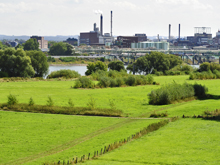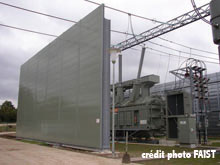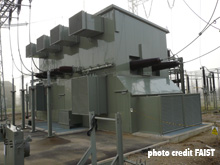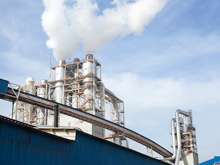Noise annoyance for environment often results from the coexistence of activities (e.g. industrial, commercial) and, in more or less close or distant outskirts, residential areas or offices (in the broad sense of the term: buildings) which constitute Zones with Regulated Emergence (ZREs). For Establishments Classified for Environmental Protection (ECEP), and for other sites, ITS offers diagnosis and solutions (i.e. sound insulation hardware) for the prevention/treatment of noise pollution in the environment.

ITS offers diagnosis and solutions against noise annoyance in environment |
Noise annoyance in environment: diagnosis offered by ITS
The diagnosis proposed by ITS in terms of noise annoyance in environment is based on measurements, in the vicinity of a facility (and sometimes, when it comes to identifying noise sources, characterizing their sound emissions: within its perimeter):
- by a human resource experienced in physical measurements, specialized in instrumental techniques
- with metrological chains (sound level meters, measuring the sound pressure level at specified locations) duly checked and calibrated
- with specialized data processing software
Depending on the case, the diagnosis carried out by ITS in terms of noise pollution in the environment may include:
- a compliance review
- a hierarchitization of noise sources, depending on their impact at different points of interest
Emergence is defined as the difference between the A-weighted equivalent continuous pressure levels of the ambient noise (installation in operation) and the residual noise (in the absence of the noise generated by the installation, but measured over the operating period of the installation).
Permissible values of emergence must be respected by the Establishments Classified for Environmental Protection (ECEP), variables according to the considered period and according to the level of ambient noise.
For the period 7 am - 10 pm (except Sundays and holidays), the permissible emergence is 6 dB(A) for an ambient noise level between 35 dB(A) and 45 dB(A) and 5 dB(A) for an ambient noise level greater than 45 dB(A).
For the period 22h - 7h (and for Sundays & public holidays), the permissible emergence is 4 dB(A) for an ambient noise level between 35 dB(A) and 45 dB(A) and 3 dB(A) for an ambient noise level greater than 45 dB(A).
In addition, always with a view to preventing noise nuisance for environment (i.e. for the neighborhood): closer to the facilities, in limit of property, the noise levels must not exceed 70 dB(A) for the day time and 60 dB(A) for the night time or even lower values fixed by a prefectural decree.
On the other hand, the difference in level between the third octave band and the four nearest third octave bands (the two immediately lower bands and the two immediately higher bands) shall not reach (and still less: exceed the following levels for the band in question: 10 dB from 50 Hz to 315 Hz, 5 dB from 400 Hz to 1250 Hz, 5 dB from 50 Hz to 315 Hz, otherwise a marked tone is detected (in an unweighted spectrum of one-third octave), also being of a nature to potentially induce a noise nuisance for residents.
Noise pollution in the environment: solutions offered by ITS
When the analysis of the results of acoustic measurements reveals a non-conformity of the installation, ITS can carry out (by mobilizing an acoustical engineer qualified in building physics) a service consisting in the study and the search for solutions to a problem whose consequences, being variable, can (as far as the industrialist, whose installation is the source of the noise disturbance, is concerned) go as far as (in some cases, in France) the suspension of the authorization to operate the site.
To comply with the regulations in force (in France), various soundproofing actions can be considered with respect to noise sources that could negatively impact the sound ambiance in the vicinity of facilities i.e. to cause noise pollution for the environment.
Sound-insulated buildings (or if the acoustic protections are smaller: sound enclosures) can host noise sources such as production lines, workshop machines or auxiliary equipment e.g. for the production of energy (motors, turbines).
Silencers can limit the sound emission of equipment involving fluids either in relation to the processes of the installation in question (air intakes, vents, chimney outlets, aero-condensers and chillers) or in connection with related equipment e.g. Heating Ventilation Air Conditioning (HVAC).
Screens (noise barriers) can limit the sound propagation outdoors, so installed either at ground level or on the roof, depending on the location of the noise sources to be treated.

acoustical screen against environmental noise annoyance |

soundproof building against environmental noise annoyance |

silencer against environmental noise annoyance |
ITS can size and market all soundproofing equipment intended to prevent noise annoyance for environment.
Tailor-made, or selected from existing ranges of products and construction systems, the solutions offered by ITS to fight against noise annoyance in the environment (following - or not - an on-site diagnosis carried out by ITS) meet the needs of each project, taking into account all its aspects (e.g. regulatory and normative, technical, economic) for optimal integration in all contexts.
A single interlocutor from the beginning to the end is sometimes what is sought: ITS can offer it.
Spread the word !